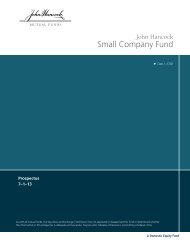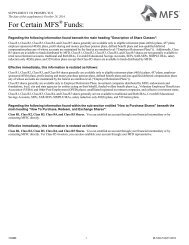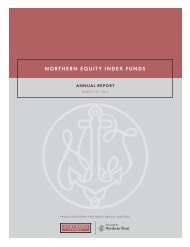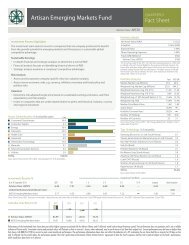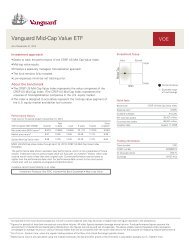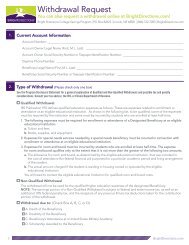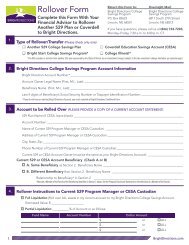Dodge & Cox Funds Statutoary Prospectus dated May 1, 2013
Dodge & Cox Funds Statutoary Prospectus dated May 1, 2013
Dodge & Cox Funds Statutoary Prospectus dated May 1, 2013
Create successful ePaper yourself
Turn your PDF publications into a flip-book with our unique Google optimized e-Paper software.
apidly changing economic, market, and politicalconditions, portfolio turnover may be higher than in amore stable period. A higher turnover rate might result inincreased transaction expenses and the realization ofcapital gains and losses (see Federal Income Taxes). Inseeking to achieve the objective of the Fund, <strong>Dodge</strong> &<strong>Cox</strong> may lend the Fund’s portfolio securities.INVESTMENT RESTRICTIONSThe <strong>Funds</strong> are subject to additional investmentrestrictions which are described in the SAI.The percentage limitations included in thisprospectus and SAI apply at the time of purchase of asecurity. So, for example, if a Fund exceeds a limit as aresult of market fluctuations or the sale of other securities,it will not be required to dispose of any securities.INVESTMENT RISKSYou should understand that all investments involve risks,and there can be no guarantee against loss resulting froman investment in the <strong>Funds</strong>, nor can there be anyassurance that a Fund’s investment objective(s) will beattained. There are further risk factors described elsewherein this prospectus and in the SAI.Investing in Equity and Debt Securities Investmentsin equity securities are subject to market risks that causetheir prices to fluctuate over time (i.e., the possibility thatstock prices will decline over short or extended periods).Prices of debt securities are sensitive to changes in themarket level of interest rates. In general, as interest ratesrise, the prices of debt securities fall, and conversely, asinterest rates fall, the prices of these securities rise.Interest rate changes can be sudden and unpredictable.Yields on short, intermediate, and long-term securities aredependent on a variety of factors, including the generalconditions of the money and debt securities markets, thesize of a particular offering, the terms and conditions ofthe obligation (e.g., maturity, coupon, and call features),and the credit quality and rating of the issue. Debtsecurities with longer maturities or lower credit qualitytend to have higher yields and are generally subject togreater price volatility than obligations with shortermaturities and lower yields or higher credit quality.Furthermore, because yield levels on securities vary withchanging interest rates, no specific yield on shares of aFund can be guaranteed.Current market conditions may pose heightened risksfor <strong>Funds</strong> that invest in debt securities. In many countries,interest rates are at or near historic lows, and future increasesin interest rates could result in less liquidity and greatervolatility of debt securities. In addition, new regulationsapplicable to and changing business practices of financialintermediaries that make markets in debt securities mayresult in those financial intermediaries restricting theirmarket making activities for certain debt securities, whichmay reduce the liquidity and increase the volatility for suchdebt securities. The growth of the bond market relative todealer capacity may reduce further liquidity, particularly intimes of market stress. The liquidity of an issuer’s securitiesmay also decrease if its credit rating falls, it experiencessudden unexpected cash outflows, or some other eventcauses counterparties to avoid trading with or lending to theinstitution.Since the <strong>Dodge</strong> & <strong>Cox</strong> Income Fund, the <strong>Dodge</strong> &<strong>Cox</strong> Global Bond Fund, and the debt portion of the<strong>Dodge</strong> & <strong>Cox</strong> Balanced Fund will be invested primarily ininvestment-grade debt securities, the <strong>Funds</strong> generally willnot yield as high a level of current income as funds thatinvest primarily in lower-quality debt securities whichgenerally have less liquidity, greater market risk, and greaterprice volatility.The value of equity and debt securities may also beaffected by credit risk, i.e., changes in the financialcondition of, and other events affecting, specific issuers.For example, a Fund could lose money if the issuer orguarantor of a debt security, or the counterparty to aderivative instrument, repurchase agreement, or a loan ofportfolio securities is unable or unwilling to make timelyprincipal and/or interest payments, or to otherwise honorits obligations. If an issuer defaults, or if the credit qualityof an investment deteriorates or is perceived todeteriorate, the value of the investment could decline.Debt securities are also subject to call risk andextension risk. Call risk is the chance that during periodsof falling interest rates, issuers of callable bonds may call(repay) securities with higher interest rates before theirmaturity dates. A Fund could lose potential priceappreciation and may be forced to reinvest the proceeds atPAGE 34 ▪ D ODGE & C OX F UNDS




